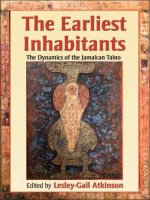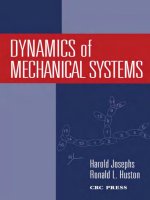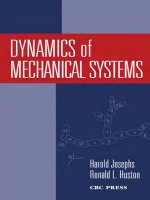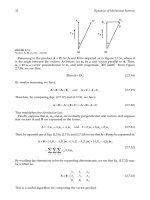Time dependent quantum wave packet dynamics of 3d systems
Bạn đang xem bản rút gọn của tài liệu. Xem và tải ngay bản đầy đủ của tài liệu tại đây (10.03 MB, 144 trang )
TIME DEPENDENT QUANTUM WAVE
PACKET DYNAMICS OF 3D SYSTEMS
Lin Xin
Dec 2008
A THEIS SUBMITTED
FOR THE DEGREE OF DOCTOR OF PHISLOSOPHY
DEPARTMENT OF PHYSICS
NATIONAL UNIVERSITY OF SINGAPORE
- I -
Content
Content I
Acknowledgements III
Abstract IV
List of Tables VI
List of Figures VII
1. Introduction
1.1 Development of quantum reaction dynamics 2
1.2 Beyond Born-Oppenheimer approximation 5
1.3 Approaches to modeling nonadiabatic dynamics 7
1.4 Introduction to State-to-State reaction dynamics 13
1.5 Brief introduction to studies performed 14
1.6 References 16
2. TD treatment for 3D systems
2.1 Solving TD Schrodinger equation for 3D system 18
2.1.1 Hamiltonian and basis set 19
2.1.2 Solving TD Schrodinger equation 22
2.2 Quantum dynamics of nonadiabtic systems 27
2.2.1 Adiabatic representation and diabatic representation 27
2.2.2 Quantum dynamics in diabatic representation 36
2.3 TD wavepacket approach to State-to-State reactive scattering 39
2.3.1 Expression of S matrix elements 39
2.3.2 TD expression of S matrix elements 42
2.4 References 45
3. H
2
+ H reaction dynamics with Diabatic basis sets
3.1 Introduction 47
3.2 Propagation of wavepacket on diabatic PES 48
3.3 Results and Discussion 59
- II -
3.3.1 H
2
+ H nonadiabatic reaction on an analytic surface 59
3.3.2 The isotope reaction 68
3.3.3 H
2
+ H nonadiabatic reaction on a new diabatic surface 73
3.4 Summary 79
3.5 Reference 80
4. State-to-State Reactive Scattering of 3D systems: A new TD approach
4.1 Introduction 84
4.2 A new TD treatment for State-to-State reactive scattering 87
4.3 Results and discussion 94
4.3.1 Application to H
2
+ H reactive scattering 94
4.3.2 Cl + H
2
State-to-State calculation 105
4.3.3 H + O
2
State-to-State calculation 111
4.4 Summary 121
4.5 Reference 122
5. Summary
- III -
Acknowledgement
This thesis is the result of a few years of working during which I have been accompanied and
supported by many people, and any merit in it is in large measure due to them.
My most earnest acknowledgment must go to my supervisor Dr. Zhang Donghui for his
guidance and assistance throughout the course of the thesis study. I have seen in him an
outstanding advisor who can bring the best out from his students, and an excellent researcher
who is always enthusiasm for his works.
My sincere thanks go out to Dr. Lu Yunpeng, Dr. Zhang Liling and Dr Sun Zhigang. I
could not have imagined working without them who have been encouraging and helping me
especially in the last two years.
Finally, and importantly, I would like to thank all the people around, without you, life
will simply be different. Thanks!
- IV -
Abstract
This thesis presents extensive study of atom-diatom chemical reaction dynamics with time-
dependent wavepacket method. In this study, theoretical investigations have been performed,
towards nonadiabatic dynamics in diabatic representation and a new strategy for state-to-state
dynamics study.
Specially, the quantum mechanical study on the reactive scattering of H
2
+ H and its
isotopic reactions has been performed on two different potential energy surfaces, respectively
the double many body expansion surface and a newly developed surface constructed by
interpolation from ab intitio data points. Diabatic dynamics have displayed insignificant
nonadiabatic coupling effect that coupling between the two lowest potential energy surfaces
of H
3
didn’t have any dramatic effect on the reaction probabilities. Diabatic representation has
demonstrated its effectiveness and convenience in treating reactions with nonadiabatic effect
by including explicitly the effect of conical intersection which have been studied in the
literature in term of the geometric phase change of the adiabatic electronic wavefunction. The
dynamics study performed has displayed the quality of the interpolation surface and
sensitiveness of dynamics results responding to the detailed change in the surface including
the derivative coupling. At the same time, dynamics calculations have helped to improve the
interpolation of the derivative coupling term.
The time-dependent wavepacket method has been presented with a new strategy for
state-to-state dynamics calculation. With this strategy, the coordinates’ problems encountered
by most of the state-to-state dynamics studies are avoided by solving dynamics processes in a
single reactant Jacobi coordinates. The product state generation probabilities are determined
by interpolating their wavefunction at each propagation time step on their discrete variable
points which is defined and optimized in the product Jacobi coordinates. This strategy has
been applied to the studies of H
2
+ H and Cl + H
2
reactions. State-to-state differential cross
sections have been obtained for these two reactions using an exact time-dependent quantum
- V -
wavepacket method. This strategy has been further applied to extract state-to-state reaction
probabilities of H + O
2
reaction. The advantage of this strategy has been well demonstrated
that it allows state-to-state reaction probabilities and cross sections to be calculated efficiently.
And it is enlightening to the development of more efficient exact quantum method for
simulating reactive scattering processes.
- VI -
List of Tables
3. H
2
+ H Reaction Dynamics on Diabatic Potential Energy Surface
Table 1. Parameters used in TD wavepacket calculation 53
4. State-to-State Reactive Scattering of 3D systems: A new TD approach
Table 1. Parameters used in TD wavepacket calculation (H + H
2
) 95
Table 2. Comparison between S matrix elements from ABC code and current study 98
Table 3. Parameters used in TD wavepacket calculation (Cl + H
2
) 106
Table 4. Parameters used in TD wavepacket calculation (H + O
2
) 115
5. Summary
Table 1. Parameters used in TD wavepacket calculation (H + O
2
) by the new method 132
Table 2. Parameters used in TD wavepacket calculation (H + O
2
) by the PCB method 133
- VII -
List of Figures
2. TD treatment for 3D systems
Figure 1. Body-Fixed Jacobi coordinates for A + BC 20
Figure 2. Two Body-Fixed Jacobi coordinates arrangements of the A + BC reaction 40
3. H
2
+ H Reaction Dynamics on Diabatic Potential Energy Surface
Figure 1. H
2
asymptotic potential 49
Figure 2. H
3
2D minimum potential and initial wavepacket position 50
Figure 3. Distribution of pseudo rotation angle 52
Figure 4. Propagation of wavepacket on DMBE potential surface 55
Figure 5. Electronic population distribution as a function of propagation time 56
Figure 6. Total reaction probability for H + H
2
, nonadiabatic and diabatic results 60
Figure 7. Total reaction probabilities for J = 0, 10, 20, 30, 40 61
Figure 8. Weighted partial wave for energy 3.5 eV and 2.0 eV 62
Figure 9. Weighted partial wave for energies 0.5 eV to 4.0 eV 63
Figure 10. Total reaction probabilities (1 – 3, 0) 65
Figure 11. Total reaction probabilities ( 0 , 1 – 3) 66
Figure 12. Total reaction probabilities for H + HD, product channel specified 69
Figure 13. Total reaction probabilities for J = 0, 10, 20, 30 71
Figure 14. Comparison between asymptotic potential from DMBE and the new PES 74
Figure 15. Electronic population distribution as a function of propagation time 75
Figure 16. Total reaction probabilities on the new PES 76
Figure 17. Total reaction probabilities on the new PES (with smoothed interpolation) 78
4. State-to-State Reactive Scattering of 3D systems: A new TD approach
Figure 1. Schematic plot of interpolation points location 88
Figure 2. Distribution of interpolation points on the 2D minimum potential 96
Figure 3. State resolved reaction probabilities for H + H
2
(J = 8) 97
Figure 4. State-to-state differential cross sections for H + H
2
(0, 0)→(0,0/5) 99
Figure 5. Energy-angle contour map of differential cross sections, H + H
2
(0,0)→(0,0) 100
Figure 6. Energy-angle contour map of differential cross sections, H + H
2
(0,0) →(1,0) 102
- VIII -
Figure 7. Energy-angle contour map of differential cross sections, H + H
2
(0,0) →(0,5) 103
Figure 8. Energy-angle contour map of differential cross sections, H + H
2
(0,0) →(1,5) 104
Figure 9. State resolved reaction probabilities for Cl + H
2
(J = 0) 107
Figure 10. Energy-angle contour map of differential cross sections, Cl + H
2
(0,0) →(0,0) 108
Figure 11. Energy-angle contour map of differential cross sections, Cl + H
2
(0,5) →(1,0) 109
Figure 12. State-to-state differential cross sections, Cl + H
2
(0,0/5) 110
Figure 13. Long range attractive potential in the product O + OH channel 113
Figure 14. Total reaction probabilities, H + O
2
(0,0) for J = 4 114
Figure 15. Total and final state resolved reaction probabilities, H + O
2
117
Figure 16. Reaction probabilities for H + O
2
(0,1)
→ O + HO (0,0 – 19) 119
5. Summary
Figure 1. Total reaction probabilities for H + D
2
+
reaction. 130
Figure 1. Complete differential cross section of H + O
2
134
1
Chapter 1
Introduction
Chemical reaction dynamics has long been an important field in physical chemistry
and chemical physics research. Chemical reactions include a series of basic processes
from the transfer of electrons or protons to the transfer of groups of nuclei between
molecules, that is, the breaking and formation of chemical bonds. The research in
chemical reaction dynamics provides crucial support to atmospheric chemistry,
interstellar chemistry, combustion chemistry and so on. The conceptual approach to
describe chemical reactions at a detailed molecular level from first principles is very
simple and has been known for decades. Starting from the Hamiltonian of the system, the
electronic potential energy surface (PES) can be computed, and which governs the
motion of nuclei. By solving the equation of nuclear motion, various dynamics
information such as the reaction probabilities and quantum state-to-state scattering cross
sections can be obtained. These are physical observables of chemical reactions and can be
compared with experiments.
The development of sophisticated ab intitio quantum chemistry has provided
researchers with tools to obtain accurate global PES which has both energetic as well as
structural information. Combining results from quantum dynamics calculations
performed on such PES with detailed analysis, mechanisms of elementary chemical
reactions can be studied in great detail.
2
In recent years, theoretical treatment of chemical reaction dynamics has undergone
spectacular development, prompted partially by the progress in experiments which have
advanced so much and now offer detailed scattering information for theory to explain and
rationalize. At the same time, advances in computer and networking technologies for
parallel computing are giving new possibilities for theoretical studies of chemical
reaction dynamics. However, to have a good understanding and complete scenario of the
development in theoretical studies of chemical reaction dynamics, it is necessary to start
with the Born-Oppenheimer (BO) approximation, which was proposed in 1927 and is still
indispensable in quantum chemistry and dynamics.
1.1 Development of quantum reaction dynamics
The BO adiabatic separation [1] of electronic and nuclear motion provides a widely
adopted framework to studying molecular energy levels and reaction processes. Under
this quantum mechanical framework, motion of electrons is separated from that of nuclei
based on the rationale that nuclei are much more massive than electrons. And it is
assumed that the nuclei move on a single adiabatic electronic state or PES. BO adiabatic
separation leads to the decoupling of Hamiltonian into two terms. Therefore, the total
eigenfunctions are represented by direct product of two individual eigenfunctions in
terms of electrons positions and nuclei positions. Mainly two assumptions are made that
the electronic wavefunction depends upon the nuclei positions but not upon their
velocities and the nuclear motion sees a smeared out potential from the speedy electrons.
The BO adiabatic separation has been applied profitably in the study of reaction
dynamics. In 1974 the first accurate calculation of differential and integral cross section
3
for H + H
2
exchange reaction was performed [2]. This is the first rotationally and
vibrationally converged result for 3 dimensional (3D) systems. Cross sections are the
quantitative description of reaction likelihood. As mentioned, theoretically obtained cross
sections can be compared directly to experiment result. With the constructing of accurate
PES later [3,4], first converged accurate quantum dynamic calculation of 3D system
reactive scattering is made available soon after [5]. Since 1980s, rapid progress has been
made in the theoretical study of quantum reaction dynamics [6-12], calculations of simple
3D systems became just routine applications. Researchers were proceeding to higher
dimensional systems in 1990s, great success has been achieved [13-19]. In all these
works, since the BO approximation was adopted, accurate dynamic information for
reactions on a single PES was obtained.
When accurate PES is available, to solve the equations of nuclei motion, either a
time-independent (TI) or time-dependent (TD) approach can be adopted. TI approaches
evaluate scattering properties by integrating the stationary Schrödinger equation; usually
a coupled-channel (CC) scheme[20] is implemented. The scattering matrix S is obtained
for all energetically open transitions at a single energy, and from which the cross sections
can be obtained. TD approaches, on the other hand, obtain the dynamic information for
specific initial state at various energies by solving the TD Schrödinger equation.
In early 1990s, as the natural extension to the traditional approach to solving the
stationary Schrödinger equation for nonreactive scattering problems, TI method is much
more developed and better established. TI method has the advantage that the S matrix can
be obtained directly while its TD counterpart needs a number of propagations to build the
S matrix. More importantly, since the TD wavepacket is propagated on finite numeric
4
grid, an absorbing potential must be implemented near the boundary to overcome the
artificial reflection problem. This parameterized absorbing potential will affect the
convergence and need to be adjusted regularly according to different translational energy
range.
TI method has been applied successfully to systems with up to 3 atoms. For
reactions involving four atoms, TI calculations for total angular momentum J > 0 become
extremely difficult since they scale as N
3
with N being the number of basis functions. TD
method’s major advantage is that, being a vector-matrix multiplication method, it scales
better than N
2
. This scaling advantage of TD method means that, with certain
computational power limitation, it is the method of choice for high dimensional systems
or complicated 3D systems which require large number of basis functions. The advantage
of TD method also lies within its conceptual simplicity and transparency since it
simulates the reaction by propagating a wavepacket from the reactant asymptotic region
to product asymptotic region, which represents the reactant to product transition. TD
method will be the most efficient when dynamics information is required for a limited
number of initial quantum states of the reactant. Therefore, it has particular advantages
for calculations related to experiments in which reactant in specific state is involved.
With the scaling advantages, the efficiency of TD method also depends on the basis
set selection and the time propagation method. Currently, various sophisticated
propagation methods have been developed and implemented successfully, such as the
split-operator (SP) method [21] , Chebychev polynomial method [22], short iterative
Lanczos method [23], real wavepacket [24] and others. However, if state-to-state
probabilities or cross sections are required, the propagation becomes more complicated.
5
The wavepacket must be transformed from reactant to product coordinates. To date, the
most successful TD method for calculating state-to-state quantities is based on the
Reactant Product Decoupling (RPD) [13,25] approach which partitions the full TD
wavefunction into a sum of reactant and all product components.
The well developed TD method is quite successful in dealing with different high
dimensional systems. However for systems with a deep well in the PES, TD method
needs a long propagation to get converged result. These long-lived resonances require the
wavepacket to be propagated for an unfeasible number of time steps. This will cancel out
the scaling advantage of TD method against its TI counterpart. The advantage and
disadvantage of TD and TI methods have been discussed extensively in past two
decades[26-28], the choice of method is system dependent.
1.2 Beyond Born-Oppenheimer approximation
Although the well established success of the BO adiabatic approximation in the
areas of reaction dynamics as well as molecular spectroscopy is likely to secure itself as a
continuing foundation of molecular science, the range of dynamical processes lies within
its scope is far from complete. For example, the reactive charge transfer of H
+
+ D
2
→
HD + D
+
reaction can not be simulated on a single PES successfully. In this reaction, the
electronic states of the reactant and product are different and the HD + D
+
product
channel is induced by strong nonadiabatic transition. Therefore, dynamics calculations
for this reaction need to be performed on at least two coupled PESs simultaneously. Not
only the process of charge transfer but also dynamics at metal surfaces, radiationless
6
processes in molecules or solids, inelastic collision, visible and ultraviolet photo-
chemistry, chemiluminescent reactions and many recombination reactions usually
involve more than one PES and transitions between them [29-33]. For these cases, the
BO approximation can break down due to the presence of strong nonadiabatic couplings
between degenerate electronic states or between the near-degenerate ones. These
couplings allow the motion of nuclei on coupled multiple adiabatic electronic PESs. In
such processes when the energy gap between two PESs is small, the nuclei can transmit
into electronically excited states. This may result in significantly different dynamic
properties.
In 1930s, the crossing of potential surfaces was first studied [34], and the Jahn-
Teller conical intersection model was established. A later study showed that the conical
intersections described by Teller will occur not only in situations where symmetry
demands them, but also in asymmetrical systems. As the outcome of nonadiabatic
coupling, electronic adiabatic eigenfucntions related to conical intersections are
characterized by two interesting features: first they are parametrically dependent on the
nuclear coordinates; second they are multivalued. Assuming the adiabatic electronic
wavefunctions to be real and as continuous as possible regarding nuclear coordinate,
when the polyatomic system is transported around a close loop at conical geometry, the
electronic wavefunction must change sign. This change of sign must be accompanied by
the compensatory sign change in the adiabatic nuclear wavefunctions to make the total
wavefunction single valued. This is known as the geometric phase (GP) effect, which
leads to important consequences for the structure and dynamics of polyatomic systems. It
is later suggested that based on the Janh-Teller conical intersection model the phase
7
factor should be related to the adiabatic-to-diabatic transformation angle as calculated for
a two state system.
Theoretically, nonadiabatic effects are outcome of the Born-Oppenheimer-Huang
treatment in which the BO approximation breaks down. Together with the adiabatic PESs,
nonadiabatic coupling terms govern the motion of nuclei in molecular system, including
the nonadiabatic transition. With the nonadiabatic coupling terms included explicitly,
reaction dynamics calculations can reach to a better agreement with experiment results
for systems with prominent nonadiabatic effect. In fact, the nonadiabatic dynamics
process can be decomposed into sequential events of nonadiabatic transmission between
different PESs (electronic states) and adiabatic wave propagation along adiabatic PESs.
Therefore, nonadiabatic dynamics calculation appears to be quite similar to its adiabatic
counterpart except that the nonadiabatic transition needs to be evaluated during the
propagation. In some recent works, full dimensional quantum mechanical treatment to 3
atom systems either with adiabatic basis set or diabatic basis set has been reported.
Sophisticated semiclassical treatments to nonadiabatic coupling have been seen for even
longer time.
1.3 Approaches to modeling nonadiabatic dynamics
A. Semiclassical methods:
Although accurate quantum mechanical treatment is always desired, due to the
unaffordable computational costs, researchers would turn to semiclassical approaches
when treating dynamics of systems larger than a few atoms. The strategy is to retain the
8
treatment for most dimensions of freedom classical, while designating a few crucial
degrees of freedom to be analyzed quantum mechanically. More specifically, quantized
vibrational level, zero-point motion and tunneling through reaction barriers require
quantum mechanical descriptions. As they can not be well described in classical methods,
freedom associated with them must be considered quantum mechanically. The crucial
issue in mixed quantum-classical dynamics is the self-consistency. The quantum
mechanical degrees of freedom must evolve correctly with other classical motions, while
the classical degrees of freedom must respond effectively to quantum transitions.
Among a number of standard approaches which describe the dynamics of a
quantum system interacting with a classical one, the Redfield approach is one of the
notables. The multilevel Redfield theory could be used to treat electron transfer dynamics
in a dissipative environment [35], and is valid for arbitrarily large electronic coupling.
Although the formalism of Redfield theory allows proper incorporation of finite
vibrational energy relaxation and dephasing rates into the description of electron transfer
dynamics, it can not describe the back reaction of the quantum system on the classical
one properly. For the classical path method, the same problem lies within. Therefore,
surface-hopping approach has emerged to treat the interactions between quantum and
classical systems in a self-consistent way.
In 1971 Tully [36] introduced the trajectory surface hopping approach to solve the
nonadiabatic molecular collisions of the H
+
and D
2
system. Surface hopping is an
extension of the classical trajectory approach which is developed to introduce classical-
quantum correlation. Assumption is made that nuclei move classically on a single PES
until surface crossing region or other region with strong nonadiabatic coupling is reached.
9
In such region, the trajectory is split into two braches and they move on different PES. At
the point of splitting, the probability of trajectory switching to another PES is calculated
with a slight velocity correction, which is applied to conserve energy and angular
momentum.
With the trajectory surface hopping approach, nonadiabatic transition is
represented as a hop from one adiabatic PES to another. It is assumed that such hops can
occur only at a finite number of distinct points along any trajectory. Therefore,
determination of the positions for these points is one of the important issues. Another
important issue is determination of the hopping probability and the correction term.
Surface hopping is based on a multi-configuration expansion of the total wavefunction, it
is valid for the adiabatic and diabatic representation, but because of the independent
trajectory approximation of surface hopping, the transition between states is not measured
rigorously. And it should be noticed that surface hopping is not invariant to the choice of
quantum representation [37,38], so the hopping algorithm is not unique. The advantage of
surface hopping is that it usually provides accurate quantum transition probabilities,
conserves total energy and satisfies microscopic reversibility either rigorously or
approximately depending on the hopping algorithm.
An alternative to surface hopping is the mean filed method, it is based on a mean-
field separation of classical and quantum motions. Compared to surface hopping, it is
invariant to the choice of quantum representation [37,38]. Despite the common
deficiency of all mean-field methods, which do not describe the correlation between
classical quantum motions, it provides accurate quantum transition probabilities and
properly conserves total energy.
10
The underlying approximations of these two approaches determined their strengths
and weakness. Accuracy of these methods depends somehow to the property of systems
they are applied to [39,40]. Although some other recent semiclassical developments also
appear promising, fully quantum treatment to nonadiabatic systems is always desired
despite the high computational demands. With the rapid development of computer
technology, accurate quantum calculations have already been performed to systems with
up to 4 atoms. Dynamics of low dimensional nonadiabatic system can be studied
quantum mechanically.
B. Quantum mechanical treatment of nonadiabatic system.
Accuracy of semiclassical methods is system dependent, accurate quantum
mechanical results for realistic full-dimensional nonadiabatic systems allow for the
systematic study of the accuracy of approximate methods, which could be applied to
higher dimensional systems. Furthermore, full-dimensional quantum mechanical
treatment is always desired, since the accuracy and effectiveness in describing quantum
effect in dynamics can never be compromised by the high computational demands.
The non-BO dynamics calculation could be carried out once an accurate
representation of the PESs and their coupling is obtained in either the adiabatic or
diabatic representation. In theoretical treatment, each of these two representations has its
own strength and weakness. Adiabatic representation is well defined, it lends itself well
to using vairational and perturbation theory methods, and in principle it provides basis for
exact treatment. However, the adiabatic framework is characterized by the adiabatic
11
surfaces and the nonadiabatic coupling terms. With the usually spiky and frequently
singular nonadiabatic coupling term, the adiabatic framework is inconvenient for solving
the nuclear Schrödinger equation in most cases. The singularity of nonadiabatic coupling
term may affect the stability of the numerical solution. Furthermore, it may dictate certain
boundary conditions that may not be easily implemented for getting the solution.
The diabatic representation, on the contrary, is not strictly defined. However,
diabatic surfaces and couplings are smooth. This gives rise to easier treatment and more
stable numerical solution to the Schrödinger equation. Therefore, transformation from
adiabatic framework to diabatic framework, termed as diabatization, is essentially
enforced when multistate problem is encountered. A common practice for diabatization is
to follow a two steps strategy: first forming the Schrödinger equation within the adiabatic
framework, second employing a unitary transformation that eliminates the nonadiabatic
coupling terms by replacing them with relevant potential coupling terms. Such
transformation is not unique. However this will not affect the solution of the Schrödinger
equation.
With either adiabatic or diabatic representation, accurate dynamic calculation can
be carried out with quantum mechanical scattering theory. Early quantum reactive
scattering calculations for H + H
2
reaction included GP was performed using multivalued
basis function [41]. Although the GP was found to change markedly the state-to-state
rovibrational product distribution, and led to good agreement with experimental
measurements, subsequent comparison showed that the product state distribution and the
differential cross sections agreed with calculations which ignored the GP effect [42]. In
several later works, accurate quantum scattering calculations have also been performed
12
for the same reaction and its isotope. These calculations are based on summarized
hyperspherical coordinates with a hybrid basis which accurately treats the singularities
appear in the kinetic energy operator in the Body-Fixed (BF) coordinate. The GP has
been investigated using both the vector potential approach and the double-valued basis
set approach. And the consequence of GP in such reaction has been found to be
negligible [43-45]. In more recent studies [46-48], diabatic approach has been adopted for
reactive scattering dynamics calculations on conically intersecting PESs. In these works,
the initial wavepacket has been prepared in a specific adiabatic electronic state, then
transformed and propagated in a suitable diabatic representation. The initial state specific
total reaction probabilities have been calculated using the flux operator both in the
adiabatic and the diabatic representation. RPD method has been modified to treat the
multisurfaces problems[47] and the state-to-state reaction probabilities have been
obtained. Results from the diabatic representation yield excellently agreement with those
from adiabatic representation.
It needs to be addressed that quantum reaction dynamics calculations can be
carried out only when accurate PES is available. This leads to the interests of research in
constructing PESs which includes accurate description of derivative coupling terms.
Although, there are many different approaches to solve the nonadiabatic quantum
reaction dynamics now, the work is still especially challenging because there are open
channels on more than one PES and also because for typical energy gaps, the kinetic
energy is high on at least one surface. In this work, TD wavepacket method has been
applied to nonadiabatic systems with the diabatic representation. In the last session of this
chapter, studies performed are briefly introduced.
13
1.4 Introduction to State-to-State reaction dynamics
Nowadays, reaction dynamics studies are being carried out targeting detailed
agreement between theory and experiment. The birth of experimental reaction dynamics
study need to be traced back to 1950s, and was marked by the introduction of crossed
molecules beams (CMB) technique. Since then, researches in this field have expanded
dramatically. In last two decades, unprecedented advance in reactive scattering
experiments have been made since the high-resolution H atom Rydberg tagging time-of-
flight was introduced in 1990s [49,50]. Experimental measurement of rovibrational state-
to-state integral and differential cross sections of an impressive wide range have been
reported on systems such as H + H
2
and its isotopes, F + H
2
and O + H
2
. To interpret
these results rigorously, often fully quantum mechanical calculations are required.
As mentioned, when TI method is applied, the state-to-state cross sections can be
obtained using the CC method, and normally in hyperspherical coordinates. TI CC
methods have particular advantage treating systems requiring relative small basis set, but
may face scaling problem when the total angular momentum and the number of basis
functions increase. The scaling problem can be resolved using TD method. However, no
general method has been found to incorporate the hyperspherical coordinates or similar
coordinates efficiently into TD calculation. Therefore, Jacobi coordinates is the choice
for wavepacket time propagation. During the propagation, the representation of the
wavepacket need to be switched between the reactant Jacobi coordinates and the product
coordinates. The coordinates transformation can be implemented only once in the
propagation midway, or continuously in time. With carefully designed initial wavepacket,
one time midway coordinates transformation can be efficiently accomplished. For certain
14
direct reactive scattering which can be easily separated to product and reactant regions,
RPD method [51] has numerical advantages also for extracting state-to-state information.
Methods for obtaining complete S matrix using TD wavepacket method usually
can be categorized into two classes, namely the time correlation function formalism for S
matrix and the scattering amplitude formalism. More details for obtaining the S matrix
will be introduced in chapter 2. In several works, the correlation function formalism has
been used successfully to obtain the state-to-state reactive scattering information in either
reactant Jacobi coordinates or in product Jacobi coordinates. The scattering amplitude
formalism is straight forward to use where the propagation of wavepacket is carried out
in product Jacobi coordinates, and it has an attractive numerical advantage that no
overlap integral need to be calculated to extract S matrix elements. However, to
implement it successfully in reactant Jacobi coordinates, strategy to evaluate final state
wavepacket efficiently in reactant coordinates is required. In this work, such strategy is
explored. With this strategy, the final state wavepacket is calculated by interpolation in
reactant Jacobi coordinates, and on DVR points defined in product Jacobi coordinates.
State-to-state reactive scattering information was obtained for 3 systems. Results showed
that with the new strategy, numerical efficiency was achieved, while the calculation
remained highly accurate. In the next session, studies performed are briefly introduced.
1.5 Brief introduction to studies performed:
Nonadiabatic dynamics of H
2
+ H
In this study, TD wavepacket method was firstly applied to nonadiabatic
dynamics study of the H
2
+ H and its isotope reactions on an analytic surface. Different
15
diabatization schemes have been tested. Initial state specific reaction probabilities on
coupled surfaces have been obtained and compared with those obtained on adiabatic
ground state surface to show the significance of the nonadiabatic coupling. The effect of
rotational and vibration excitation of the reactant on the reaction probability has been
analyzed.
The same quantum dynamics calculation has also been performed on a new
diabatic PES for H
3
. This diabatic PES is constructed by interpolation from ab initio
quantum chemistry data. Results are shown in chapter 3.
State-to-state reactive scattering of H
2
+ H, Cl + H
2
and H + O
2
With the new strategy to evaluate product wavepacket in reactant Jacobi
coordinates, state-to-state calculations have been performed for H + H
2
reaction on the
ground state. The Boothroyd-Keogh-Martin-Peterson 2 (BKMP2) PES has been used for
the demonstration with H
2
+ H reaction. The state resolved reaction probabilities were
obtained, differential cross sections were given. The results have been compared with
those obtained with the TI ABC code. Similar calculations have also been performed for
the Cl + H
2
reaction on the benchmark BW PES [52]. Final state resolved reaction
probabilities for H + O
2
reaction have been calculated. Results are shown in chapter 4.
Since this work is mainly a computational work, the code efficiency is one
important issue. In chapter 5, the development of the current code used for the
calculations in chapter 3 and chapter 4 is introduced. Results presented in chapter 3 and
16
chapter 4 are summarized up, and the code flexibility compatibility and efficiency are
evaluated.
1.6 References:
[1] R.Oppenheimer, M.B.a. (1927) Ann. Phys. (Leipizig) 84, 457.
[2] Kuppermann, G.C.S.a.A. (1975) Physical Review Letters 35, 1266-1269.
[3] Truhlar, D.G. (1977) Adv Chem Phys 36, 141.
[4] Truhlar (1976) Annual Review of Physical Chemistry 27, 1.
[5] Michael, J.V., Fisher, J.R., Bowman, J.M. and Sun, Q. (1990) Science 249, 269-
271.
[6] Tromp, J.W. and Miller, W.H. (1986) Journal of Physical Chemistry 90, 3482-
3485.
[7] Sokolovski, D., Connor, J.N.L. and Schatz, G.C. (1996) Chemical Physics 207,
461-476.
[8] Schatz, G.C. (1995) Journal of Physical Chemistry 99, 7522-7529.
[9] Miller, W.H. (1990) Annual Review of Physical Chemistry 41, 245-281.
[10] Schwenke, D.W., Haug, K., Zhao, M., Truhlar, D.G., Sun, Y., Zhang, J.Z.H. and
Kouri, D.J. (1988) Journal of Physical Chemistry 92, 3202-3216.
[11] Miller, W.H. and Zhang, J.Z.H. (1991) Journal of Physical Chemistry 95, 12-19.
[12] Peng, T., Zhang, D.H., Zhang, J.Z.H. and Schinke, R. (1996) Chemical Physics
Letters 248, 37-42.
[13] Zhang, D.H. and Light, J.C. (1996) Journal of Chemical Physics 104, 4544-4553.
[14] Zhang, D.H. and Light, J.C. (1997) Journal of the Chemical Society - Faraday
Transactions, 691-697.
[15] Zhu, W., Dai, J., Zhang, J.Z.H. and Zhang, D.H. (1996) Journal of Chemical
Physics 105, 4881-4884.
[16] Zhang, D.H. and Light, J.C. (1997) Journal of Chemical Physics 106, 551-563.
[17] Zhang, D.H., Light, J.C. and Lee, S Y. (1998) Journal of Chemical Physics 109,
79-86.
[18] Zhu, W., Zhang, J.Z.H., Zhang, Y.C., Zhang, Y.B., Zhan, L.X., Zhang, S.L. and
Zhang, D.H. (1998) Journal of Chemical Physics 108, 3509-3516.
[19] Zhang, D.H. and Lee, S.Y. (1998) Journal of Chemical Physics 109, 2708-2716.
[20] Ohsaki, A. and Nakamura, H. (1990) Phys. Rep. 187, 1.
[21] Fleck Jr., J.A., Morris, J.R. and Feit, M.D. (1976) Applied Physics 10, 129-160.
[22] Tal-Ezer, H. and Kosloff, D. (1984) J. Chem. Phys 81, 3967.
[23] Park, T.J. and Light, J.C. (1986) J. Chem. Phys 85, 5870.
[24] SK, G. and GG., B K. (1998) J. Chem. Phys 108, 950.
[25] Zhang, D.H. and Light, J.C. (1996) Journal of Chemical Physics 105, 1291-1294.

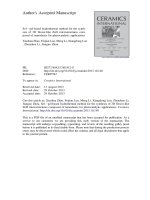
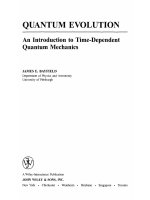
![webgl beginner's guide [electronic resource] become a master of 3d web programming in webgl and javascript](https://media.store123doc.com/images/document/14/y/iu/medium_iud1401384400.jpg)
